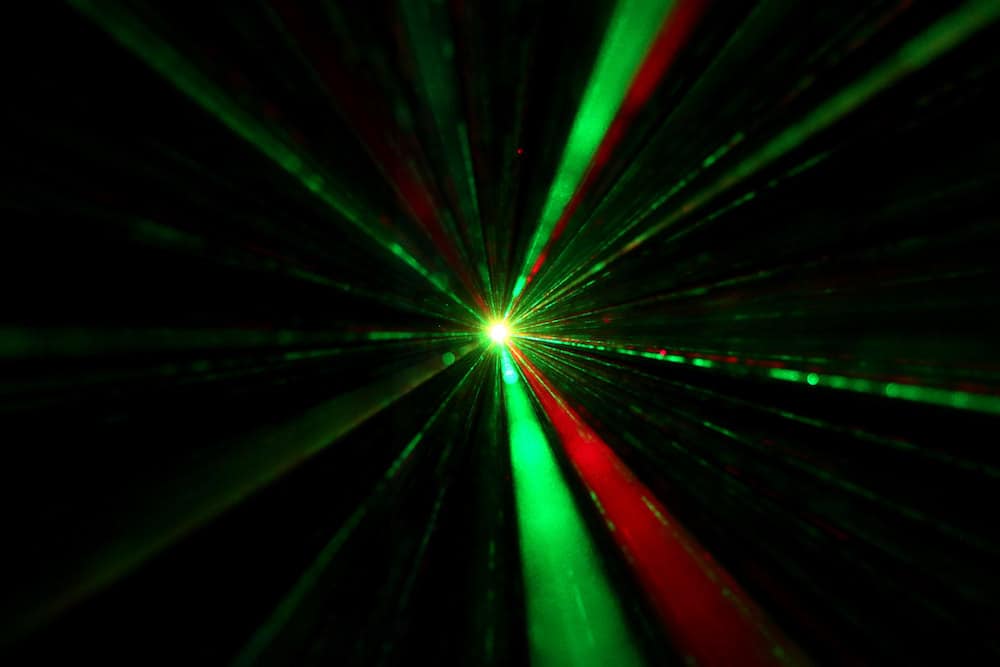
[Image above] Credit: Kevin Doncaster, Flickr (CC BY 2.0)
From communications to manufacturing to medicine, lasers play an important role in many of today’s advanced technologies.
Lasers are fairly simple devices consisting of three main parts: an energy source, a gain medium, and an optical resonator. However, scientists are constantly researching ways to improve the performance and efficiency of each part.
The gain medium, which is the material used to amplify the power of light, is a main focus in laser research. Single crystals were originally used for this purpose, but since the discovery of an optically transparent polycrystalline material with properties close to single crystals in the 1990s, so-called “transparent ceramics” now serve as the gain medium in many commercial lasers due to their simpler processing route and easier shape control compared to single crystals, among other factors.
Transparent ceramics are typically fabricated by sintering powdered materials. Researchers have conducted many studies on both the starting powders and the sintering process to understand all the factors that affect the final microstructure and thereby the optical transparency and overall lasing performance of the ceramics.
We’ve covered some of these processing studies previously on CTT. Today, we look at two more studies by a team of researchers in Singapore and China that investigate factors affecting the lasing performance of transparent ceramics.
The researchers come from Nanyang Technological University in Singapore and Jiangsu Normal University in China. Their first article, published in 2019, explored whether a common sintering aid may affect the lasing performance of the final transparent ceramic.
As noted above, microstructure is key in determining the optical transparency of a transparent ceramic. Therefore, structural features such as pores and secondary phases that could cause light to scatter must be eliminated.
Dopants such as ThO2, ZrO2, and HfO2 have been widely used to help control these features. When these dopants are added to transparent ceramics, some of the cations in the ceramics are replaced by tetravalent cations in the dopants. This replacement generates cation vacancies, leading to slower exaggerated grain growth and easier elimination of residual pores.
However, because of the charge imbalance between the ceramic’s cations and the doped tetravalent cations, the concentration of point defects is increased in doped transparent ceramics—which puts the ceramic at risk of a detrimental phenomenon called photodarkening.
Photodarkening refers to when a transparent material becomes nontransparent under electrical or irradiation excitation due to electrons or holes becoming trapped in point defects or complex defect clusters. These areas in the structure then become known as color centers, or areas that absorb additional light, and can negatively affect a material’s performance as a laser gain medium.
The researchers write that the photodarkening effect has been reported in some aliovalent ion-doped transparent materials, such as Si4+-doped YAG, Y3+-doped ZrO2, and B3+-doped SiO2. However, “to the best of our knowledge,” no studies have investigated the photodarkening phenomenon in terms of laser ceramics.
They decided to explore the photodarkening effect in laser ceramics using highly transparent Yb:Y2O3 ceramics doped with and without ZrO2. After irradiation by a 940-nm laser diode, they observed the photodarkening phenomenon in ZrO2-doped Yb:Y2O3 ceramics but not in those without ZrO2.
The absence of the photodarkening effect in the non-doped Yb:Y2O3 ceramics was reflected in lasing performance—the Zr-YbY ceramic laser had a slope efficiency of about 9%, while the non-doped YbY ceramic laser had a slope efficiency of 17%. (Slope efficiency is the ratio of the laser output power to the input pump power.)
With this demonstration that laser ceramics can experience photodarkening, the researchers wondered if any other processing parameters could lead to the phenomenon. In a follow-up paper published in December 2021, they explored whether the dispersant used in the powder synthesis process could induce photodarkening as well.
They explain that powders for laser ceramics are commonly synthesized using coprecipitation, which involves dissolving the starting materials in a common solvent and then adding a precipitating agent to form a solid.
(NH4)2SO4 is often used as a dispersant in the process, and while the addition of sulfate ions does improve the final powder morphology, it is difficult to completely remove the ions from the ceramic. Thus, “The residual sulfate ions could cause photodarkening and laser efficiency degradation,” the researchers write.
To test the possible effect of (NH4)2SO4 on lasing performance, the researchers synthesized nanocrystalline Yb:Lu2O3 ceramic powders using either (NH4)2SO4 as a dispersant or an organic dispersant called poly(acrylic acid) (PAA). Like the previous study, they used a 940-nm laser diode to irradiate the samples.
Analysis of the samples revealed “clear experimental evidence” of photodarkening in the Yb:Lu2O3 ceramics fabricated using (NH4)2SO4 as a dispersant. Again, this finding was reflected in the lasing performance—while the highest slope efficiency achieved by a (NH4)2SO4-dispersed sample was 7.2%, one of the PAA-dispersed samples achieved a slope efficiency of 21.2%, despite having a lower optical quality than the (NH4)2SO4-dispersed sample.
“Given that (NH4)2SO4 is widely used as a dispersant in the chemical coprecipitation process to obtain nanocrystalline ceramic powders with low agglomeration, and the synthesized powders are popularly used to produce laser ceramics, we believe the result reported here could be useful for the laser ceramics community,” the researchers conclude.
The 2019 paper, published in Journal of the European Ceramic Society, is “Pump laser induced photodarkening in ZrO2-doped Yb:Y2O3 laser ceramics” (DOI: 10.1016/j.jeurceramsoc.2018.10.003).
The 2021 paper, published in Optical Materials, is “Efficiency degradation of laser ceramics caused by inappropriate dispersants and sintering aids” (DOI: 10.1016/j.optmat.2021.111789).
Author
Lisa McDonald
CTT Categories
- Basic Science
Related Posts
‘Fairy circles’ may help mark natural underground hydrogen deposits
September 18, 2025


